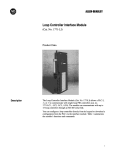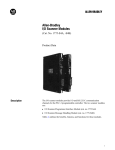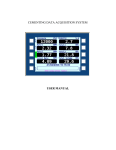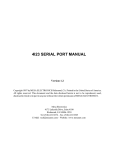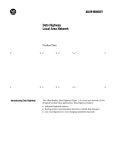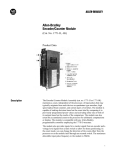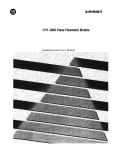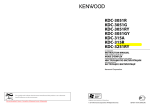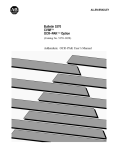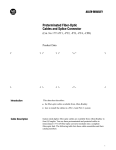Download 1771-2.34, Allen-Bradley Proportional/Integral/Derivative Control (2
Transcript
Product Data Proportional/Integral/Derivative Control (2Loop) Module AllenBradley Proportional/Integral/Derivative Control (2Loop) Module (Cat. No. 1771-PD) Product Data General Description The Proportional/Integral/Derivative Control (2-Loop) Module Assembly (cat. no. 1771-PD) is an intelligent I/O Module that performs closed loop PID control. The PID module is a process controller. It monitors the input process variable, compares the input to the desired set point, and calculates the analog output based on the control algorithm programmed in the module (figure 1). It can be used with a variety of I/O devices that operate in the +4 to +20mA or +1 to +5V DC range. 1 Product Data Proportional/Integral/Derivative Control (2Loop) Module Figure 1 PID Closed Loop Control You have a choice of control algorithm: A-B ISA Refer to Comparing ISA and A-B Algorithms and the end of this data sheet. Block transfer programming is used to communicate between the PID module and the PC processor. The PC processor writes loop configuration data such as gain constants, set points, filter values, limit and alarm values to the PID module and reads status data such as analog input values, analog output values, alarm limits and diagnostics from the PID module. The PID module can be used with any Allen-Bradley PC processor that has block transfer capability, and uses 1771-I/O. 2 Product Data Proportional/Integral/Derivative Control (2Loop) Module The PID module has five levels of fault tolerance. If communication with the PC processor is lost or withheld, the module can operate alone in soft fault mode using the last values transferred from the PC processor. If a fault in module hardware is detected, the module automatically sets the output to a predetermined value and generates a signal to transfer control to an optional user-supplied manual control station. When a manual control station is used, the manually controlled output overrides the output set by the module. Control can be returned to the PID module by a “bumpless” transfer that prevents an undesirable output surge. Another level of fault tolerance is the module’s response to loss of voltage. If +5V DC is lost, outputs go to a predetermined maximum of minimum value. If "15V DC is lost, outputs go to minimum value. Lastly, the PID module can operate from a power supply that is independent of the I/O chassis power supply. An overview of a PID module control system is shown in figure 2. Once properly configured, the PID module can operate independently of the PC processor. Or, the PID module/PC processor combination can perform adaptive control where the PC processor can continually adjust the PID module’s control algorithm based on process changes monitored by the PC processor. In addition, PID modules can be used with PC processors in distributed control systems using the data highway. Figure 2 System Overview 3 Product Data Proportional/Integral/Derivative Control (2Loop) Module Loop Features The PID module can control one or two PID closed loops. The two loops can be independent or linked together by an advanced control function such as cascade or decoupling. Expanded loop features can be chosen in addition to standard features to suit the application. All features are selectable by settings bits in the data table with the exception of the I/O range, the source of +5V DC, and the fault response to a hardware failure, or loss of +5V DC (which are selected using internal configuration plugs). Write block transfers to the module allow program logic to enable the following features: Standard Features for Input Conditioning detect the loss of process variable input read the process variable at the PC processor substitute a value calculated by the PC processor for use as the process variable take the normalized square root of the process variable digitally filter the process variable Standard Control Features select direct or reverse acting control download a set point from the PC processor limit and/or set an alarm on the error signal perform error dead band (zero crossing) set an alarm when the error exceeds the dead band select the A-B or ISA PID algorithm select error or error squared conditioning of the proportional and/or integral error select whether the derivative function operates on the error or the process variable set an alarm on the proportional term limit and/or set an alarm on the integral term limit and/or set an alarm on the derivative term Standard Features for Output Conditioning limit and/or set an alarm on the PID algorithm output read the PID algorithm output at the PC processor 4 Product Data Proportional/Integral/Derivative Control (2Loop) Module override the PID algorithm output from the PC processor interface directly with a manual control station (bumpless transfer) hold the PID algorithm output for independent loop tuning hold the bias/feedforward term for independent loop tuning download an output bias from the PC processor Expanded Features perform scaling on the process variable, set point and/or error use the tieback as the feedforward input take the normalized square root of the feedforward input add a feedforward offset multiply the feedforward term by a constant perform lead/lag filtering on the feedforward term download a feedforward value from the PC processor cascade the output of loop 1 into the set point of loop 2 decouple the VPID output of loop 1 into the feedforward input of loop 2 The module performs anti-reset wind-up on the integral output term. When a limit is set on the PID algorithm output, the integral output term is adjusted to compensate for changes in other algorithm output terms. A simplified flow chart of the PID loop algorithm (figure 3) shows selected standard and expanded loop features. 5 Product Data Proportional/Integral/Derivative Control (2Loop) Module Figure 3 Simplified PID Algorithm Block Transfer Programming 6 PID module features are selected by setting word values and control bits in data table block files. Block files are transferred between the PC processor and the PID module by bidirectional block transfers (figure 4). Product Data Proportional/Integral/Derivative Control (2Loop) Module Figure 4 Multiple Block Concept Loop data must be loaded initially from the PC processor to the PID module by a power-up load/enter sequence. Thereafter, program logic can enable continuous bidirectional communication (dynamic/status toggle sequence), or periodic bidirectional block transfers when the module operates independently of the PC processor. Either way, the PC processor can continuously monitor the status of the PID module: by continuously reading the status block by read block transfers, or by examining the module’s status monitor byte which does not require block transfers. Multiple Block Concept Data block files are areas of the PC processor data table used to store loop control words and loop values. The blocks have corresponding storage areas in the PID module. Block files required by the PID module are: Dynamic block — contains values for both loops which may change frequently. Once data has been initially loaded into the PID module, the dynamic block values can be changed at any time with a single write block transfer. The dynamic block contains 10 words for 1-loop operation or 17 words for 2-loop operation. Loop 1 Constants Block — contains values which seldom change. Once data has been initially loaded into the PID module, the loop constants can be changed only by initiating a load/enter sequence of multiple block 7 Product Data Proportional/Integral/Derivative Control (2Loop) Module transfers. The loop constants block contains 12 words for standard features or 19 words for standard and expanded features. Loop 2 Constants Block — (similar to Loop 1 Constants Block) Status Block — is used to report the current status of the PID module and any alarm condition detected by the module. The status block also prompts the next write block transfer of a dynamic block or loop constants block. The status block contains 11 words for 1-loop operation or 18 words for 2-loop operation. A summary of the words used to store feature values and associated control bits is listed in table A. Table A Control and Value Words Dynamic Block Word Title Range W01 W02 W03 W04 W05 W06 Master Control Word Control Word Dynamic Block Start Address Loop 1 Block Start Address Set Analog Output 1 Set Point 1 Scaled Proportional Gain 1 Bias 1 Process Variable 1 Feedforward Input 1 04095 04095 "99990 09999 "9999 04095 "4095 Loop 2 Block Start Address Set Analog Output 2 Set Point 2 Scaled Proportional Gain 2 Bias 2 Process Variable 2 Feedforward Input 2 04095 04095 "99990 09999 "9999 04095 "4095 W07 W08 W09 W10 W11 W12 W13 W14 W15 W16 W17 8 Product Data Proportional/Integral/Derivative Control (2Loop) Module Table A Control and Value Words (continued) Loop 1 Constant Block Word Title Title Range W18 W19 W20 W21 W22 W23 W24 W25 W26 W27 W28 W29 W30 W31 W32 W33 W34 W35 W36 Loop Control Word A Loop Control Word B Input Filter Time Constant 1 Maximum Negative Error 1 Maximum Positive Error 1 Dead Band 1 Integral Gain 1 Derivative Gain 1 Integral Term Limit 1 Derivative Term Limit 1 Minimum Output Limit 1 Maximum Output Limit 1 Loop 1 Expanded Control Word Minimum Scaling Value 1 Maximum Scaling Value 1 Feedforward Offset 1 Feedforward Gain 1 Lead Time Constant 1 Lag Time Constant 1 0999.9 04095 04095 04095 0999.9 09999 09999 09999 04095 04095 "99990 "99990 09999 09999 0999.9 0999.9 Loop 2 Constants Block Word Title Range W38 W39 W40 W42 W42 W43 W44 W45 W46 W47 W48 W49 W50 W52 W52 W53 W54 W55 W56 Loop 2 Control Word A Loop 2 Control Word B Input Filter Time Constant 2 Maximum Negative Error 2 Maximum Positive Error 2 Dead Band 2 Integral Gain 2 Derivative Gain 2 Integral Term Limit 2 Derivative Term Limit 2 Minimum Output Limit 2 Maximum Output Limit 2 Loop 2 Expanded Control Word Minimum Scaling Value 2 Maximum Scaling Value 2 Feedforward Offset 2 Feedforward Gain 2 Lead Time Constant 2 Lag Time Constant 2 0.999.9 04095 04095 04095 0999.9 09999 09999 09999 04095 04095 "99990 "99990 09999 09999 0999.9 0999.9 9 Product Data Proportional/Integral/Derivative Control (2Loop) Module Table A Control and Value Words (continued) Status Block Word Title Range W57 W58 W59 W60 W61 W62 For Future Use Alarm (both loops) Next Block Start Address Loop Time/Diagnostic Loop Status 1 Loop Error 1 Scaled Read Loop 1 Output Read Analog Input 1 Read Process Variable 1 Scaled Read Tieback Input 1 Read Feedforward Value 1 Loop Status 2 Loop Error 2 Scaled Read Loop 2 Output Read Analog Input 2 Read Process Variable 2 Scaled Read Tieback Input 2 Feedforward Value 2 "4095 "99990 04095 04095 04095 "99990 04095 "9999 "4095 "99990 04095 04095 04095 "99990 04095 "9999 W63 W64 W65 W66 W67 W68 W69 W70 W71 W72 W73 W74 Storage Requirements 10 Data table storage requirements depend on the number of control loops and on whether expanded features have been selected. Data blocks for storing the values of standard and expanded features can be arranged consecutively in the data table. A minimum of 33 words is required for one standard loop. A maximum of 74 words is required for two expanded loops (figure 5). Product Data Proportional/Integral/Derivative Control (2Loop) Module Figure 5 Block File Memory Requirements Display of Data Blocks By placing the data blocks consecutively in the data table, they can be displayed conveniently in a single data monitor display where the word numbers and position numbers of the display correspond. 11 Product Data Proportional/Integral/Derivative Control (2Loop) Module Programming Considerations The PID module has considerable programming versatility. A load/enter sequence is used to configure the module with selected features, start PID control, or to change loop constants. Data can be transferred to the module and stored indefinitely in buffer memory until activated by a program logic command. Bidirectional block transfers can be used for continuous communication between PID module and PC processor. The PC processor reads the status block, then writes the dynamic block to the module in the next I/O scan. Continuous bidirectional block transfer is useful for adaptive control where the PC processor adjusts loop values based on data received by monitoring the process. The PID module is capable of operating independently without continuous block transfer communication with the PC processor. Once the module has been initialized, the module’s general status can be monitored continuously through the status monitor byte without block transfers. The status monitor byte reports the module’s detection of a module hardware fault, loss of input, or loss of analog power. Fault Response The module detects internal hardware failures and loss of communication with the PC processor. The manner in which the module responds to a detected fault is user selectable. Hardware Fault Module response to a detected hardware fault can be selected with internal programming (jumper) plugs prior to installation (table B). In the event of a hardware fault, programming plug selection causes the module to respond in one of the following ways: sets the analog output to the minimum value (+4mA or +1V DC) holds the analog output to the last value before the fault occurred sets the analog output to the maximum value (+20mA or +5V DC) Also, when the module detects a hardware fault it automatically transfers control of the loop(s) to an manual control station (if used). The output of the manual control station can be controlled manually and overrides the module’s output. 12 Product Data Proportional/Integral/Derivative Control (2Loop) Module Loss of Voltage Module response to a detected loss of +5V DC can be selected, as well. sets analog output to minimum value (+4mA or +1V DC) sets analog output to maximum value (+20mA or +5V DC) Outputs go to minimum value if "15V DC is lost. Table B Programming Plug Positions Function Choice Plug Position hold max/min, hold last state E2 LEFT for max/min, E2 RIGHT for last state backplane external E10 IN for backplane E10 OUT for external 1 2 maximum, minimum maximum, minimum E5 OUT for max, IN for min. E4 OUT for max, IN for min. output range 1 2 I, V I, V E3, E6, E8 as shown in figure 6 E1, E2, E7 as shown in figure 6 input range 1 2 I, V I, V E15 IN for I, OUT for V E14 IN for I, OUT for V tieback input 1 2 I, V I, V E11 IN for I, OUT for V E12 IN for I, OUT for V compliance standard, additional E18 as shown in figure 6 E21, E22 IN for standard, OUT for additional. source of +5V DC back plane, external E23, E24 as shown in figure 6 Digital Board hard fault output source of +5V DC Analog Board hard fault output Note: The current range I is +4 to +20mA, the voltage range is +1 to +5V DC. 13 Product Data Proportional/Integral/Derivative Control (2Loop) Module Communications Fault The PID module detects the loss of communication with the PC processor (soft fault). Program logic enables the module to respond in one of the following ways in response to a soft fault: sets the analog output to the minimum value (+4mA or +1V DC) holds the analog output to the last PID algorithm value before the soft fault occurred performs PID control based on the last values transferred to the PID module before the soft fault occurred sets the analog output to the maximum value (+20mA or +5V DC) Switch position 1 on the last state switch assembly (I/O chassis backplane) must be set to the position for the soft fault response to operate. Note that this will cause the outputs of other modules in the same chassis to be de-energized when they detect a fault. The response for each loop can be selected independently for a hardware or communications fault. Hardware The PID module is a dual-slot module that occupies both slots of a module group. The front panel contains three LED indicators and a write-on label to record I/O ranges and the last date of calibration. Internally, the module contains a digital and an analog printed circuit board. The analog board is located beneath the module cover containing the label that identifies the connections to the field wiring arm. Internal Selections The PID module can accommodate a wide variety of applications. This is made possible by positioning a number of programming plugs inside the module. Selectable functions and corresponding programming plugs on both circuit boards are listed in table B. Programming plug locations on the analog circuit board are shown in figure 6. 14 Product Data Proportional/Integral/Derivative Control (2Loop) Module Figure 6 Programming Plug Locations (Analog Board) 15 Product Data Proportional/Integral/Derivative Control (2Loop) Module Indicators The front panel LED indicators allow an operator to observe the operating condition of the module. The indicators will be on, off or flashing (table C). Table C LED Indicators Power Requirements Indicator State Condition FAULT (red) off on normal operation hardware fault RUN (green) on flashing off toggle normal operation powerup (unprogrammed) not running loss of "15V DC STAND ALONE (yellow) off flashing toggle on normal operation soft fault loss of "15V DC block transfer program error all three off calibration mode The PID module requires 1.2A at +5V DC from the I/O chassis backplane. The module also requires 100mA at +15V DC and 100mA at -15V DC from an external supply through the field wiring arm (table D). Table D +15V DC Power Supply Specifications +15Volts 15Volts Current 100mA 100mA Voltage Tolerance 1% 1% Regulation (type) Series Series Line Regulation (for 10V AC input change) "0.2% "0.2% Load Regulation (no load to full load) "1.0% "1.0% Ripple 1mVpp 1mVpp Overvoltage Protection +18 volts 18 volts Current Limit (percent of full load) 125% 125% The source of +5V DC can be an optional external power supply wired to the field wiring arm (table E). This allows the module to be powered entirely from power supplies independent of the backplane. 16 Product Data Proportional/Integral/Derivative Control (2Loop) Module Table E +5V DC (Optional) Power Supply Wiring Specifications +5V DC Voltage (at field wiring arm) 5.05V DC Current 1.2A Voltage regulation (sum of all deviations due to line, load and ripple) "0.15V DC Rise time (to 4.75V DC) 10ms Terminal identification and connections to the module are summarized in figure 7. Typical wiring (less shielding) for I-loop control with a manual control station is shown in figure 8. Proper shielding is essential to minimize coupling of electrical noise to the PID module. The optimum grounding point(s) will vary between inputs and outputs, and voltage or current devices. Refer to the PID Module User’s Manual publication no. 1771-6.5.9) for proper shielding of input and output devices. Figure 7 Terminal Identification and Connections 17 Product Data Proportional/Integral/Derivative Control (2Loop) Module Figure 8 Typical Connections for 1Loop Control Additional Compliance 18 The maximum allowable load impedance in current mode using standard compliance is 500 ohms. Additional compliance can be established for one or two loops, if analog outputs 1 and 2 and tieback inputs 1 and 2 are selected for current mode. Additional compliance allows a maximum load impedance of 1250 ohms and is obtained by internally referencing module common to -15V DC. Product Data Proportional/Integral/Derivative Control (2Loop) Module Keying Keying bands should be used to guard against placing another type of module in a module group reserved for the PID module. Keying band positions are as follows: slot 0 (left) between 8 and 10 between 18 and 20 Comparing ISA and AB Algorithms slot 1 (right) between 2 and 4 between 28 and 30 The ISA algorithm and the Allen-Bradley algorithm are different although they achieve the same closed loop control. By understanding the differences, you can convert proportional gain, reset and rate values from ISA to equivalent A-B gain values. ISA Algorithm The equation for PID closed loop control is: VO= KC (E) + KC/TI ∫(E) dt + KC (TD)d(E)/dt Where KC = controller gain 1/T 1/TI = reset term in repeats per minute TD = rate term in minutes AB Algorithm The equation for PID closed loop control is: VO= KP(E) + KI ∫(E)dt + (KD)d(E)/dt + Bias Where Kp = proportional gain KI = integral gain in inverse seconds KD = derivative gain in seconds Comparison The ISA algorithm contains dependent variables. When you change your controller gain (KC), you also change your integral and derivative values. The A-B algorithm contains independent variables. You adjust the proportional, integral, and derivative terms independently. 19 Product Data Proportional/Integral/Derivative Control (2Loop) Module ISA Algorithm AB Algorithm Controller Gain KC (dimensionless) Proportional Gain KP (dimensionless) Reset Term 1/TI (repeats per minute) Integral Gain KI (inverse seconds) Rate Term TD (minutes) Derivative Gain KD (seconds) When using the A-B algorithm, you must convert the ISA controller gain, reset, and rate terms to gain values of the A-B algorithm. Conversion Convert ISA values to A-B values as follows: KP = KC KI = K PǒIńT I) 60 KD = KP(TD)(60) Example If your desired ISA values are: controller gain = KC = 1 reset value = 1/TI = 5 repeats per minute rate term = TD = 3 minutes convert them to A-B gain values as follows: proportional gain = KP = KC = 1 integral gain = K1 = (1)(5) = 0.083 60 derivative gain = KD = (1)(3)(60) = 180 Selecting the Algorithm You select the ISA or A-B algorithm by setting a bit in the control word. 20 Product Data Proportional/Integral/Derivative Control (2Loop) Module Specifications Process Variable Inputs Number G process variable input 1 G process variable input 2 Configuration G Differential Range (userselectable) G +4 to +20mA G +1 to +5V DC Digital Resolution G 12bit binary, 1 part in 4095 Accuracy G "0.1% of range at 25°C Input Impedance G 250 ohms (current) G 10 megohms (voltage) Common Mode Rejection Ratio G 70dB DC Common Mode Voltage Range G "200V with respect to module common Common Mode Input Resistance G 2.5 megohms Input Frequency Response G 3dB at 1kHz Maximum Allowable Input G "30mA (current) G 125V DC (voltage) Temperature Coefficient G "50 ppm/°C Tieback Inputs Number G Tieback input 1 G tieback input 2 Configuration G Single ended Range (userselectable) G +4 to +20mA G +1 to +5V DC Digital Resolution G 12bit binary, 1 part in 4095 Accuracy Maximum Power G "0.1% of range at 25°C G 3VA Input Impedance G 250 ohms (current) G 4.7 megohms (voltage) Maximum Allowable Input G "30mA (current) G 25V rms (voltage) Temperature Coefficient G "50 ppm/°C Analog Outputs Number G analog output 1 G analog output 2 Configuration G Single ended Range (userselectable) G +4 to +20mA (With output common internally referenced to power supply common, the output will drive up to a 500 ohm load over the full current range.)1 G +1 to +5V DC (500 ohms minimum load resistance, 10mA maximum load current) Digital Resolution G 12bit binary, 1 part in 4095 Accuracy G "0.1% of range at 25°C Temperature Coefficient G "50 ppm/°C Contact Output G Number G one normally closed contact, held open Peak Voltage G 30V Maximum Current G 250mA Digital Inputs from Manual Control Station G Two independent inputs for monitoring. Power Requirements Backplane or External (Digital Circuits) G 1.2A at +5V DC External (Analog Circuits) G 100mA at +15V DC G 100mA at 15V DC Other Loop Update Time G 100msec, typical Ambient Temperature Ratings G Operational 0°C to 60°C (32°F to 140°F) G Storage 40°C to 85°C (40°F to 185°F) Relative Humidity Rating G 5% to 95% (without condensation) Electrical Isolation G 1500V rms (transient) (Isolation is achieved by optoelectronic coupling between I/O analog circuits and control logic) Field Wiring Arm G 1771WF Keying G Left connector (slot 0) between 8 and 10,18 and 20 G Right connector (slot 1) between 2 and 4, 28 and 30 1 If all analog outputs and tieback inputs used are selected to current mode, the compliance of the analog outputs can be extended from 500 ohms (standard compliance) to 1250 ohms (additional compliance). This is achieved by internally referencing the outputs to 15V DC. 1985 Allen-Bradley Company. PLC is a registered trademark of Allen-Bradley Company. 21 Product Data Proportional/Integral/Derivative Control (2Loop) Module With offices in major cities worldwide WORLD HEADQUARTERS Allen-Bradley 1201 South Second Street Milwaukee, WI 53204 USA Tel: (1) 414 382-2000 Telex: 43 11 016 FAX: (1) 414 382-4444 EUROPE/MIDDLE EAST/AFRICA HEADQUARTERS Allen-Bradley Europe B.V. Amsterdamseweg 15 1422 AC Uithoorn The Netherlands Tel: (31) 2975/43500 Telex: (844) 18042 FAX: (31) 2975/60222 Publication 1771-2.34 — October, 1985 Supersedes Publication 1771-948 — July, 1983 22 As a subsidiary of Rockwell International, one of the world’s largest technology companies — Allen-Bradley meets today’s challenges of industrial automation with over 85 years of practical plant-floor experience. More than 11,000 employees throughout the world design, manufacture and apply a wide range of control and automation products and supporting services to help our customers continuously improve quality, productivity and time to market. These products and services not only control individual machines but integrate the manufacturing process, while providing access to vital plant floor data that can be used to support decision-making throughout the enterprise. ASIA/PACIFIC HEADQUARTERS Allen-Bradley (Hong Kong) Limited Room 1006, Block B, Sea View Estate 28 Watson Road Hong Kong Tel: (852) 887-4788 Telex: (780) 64347 FAX: (852) 510-9436 CANADA HEADQUARTERS Allen-Bradley Canada Limited 135 Dundas Street Cambridge, Ontario N1R 5X1 Canada Tel: (1) 519 623-1810 FAX: (1) 519 623-8930 LATIN AMERICA HEADQUARTERS Allen-Bradley 1201 South Second Street Milwaukee, WI 53204 USA Tel: (1) 414 382-2000 Telex: 43 11 016 FAX: (1) 414 382-2400 PN 955098-65 Printed in USA






















